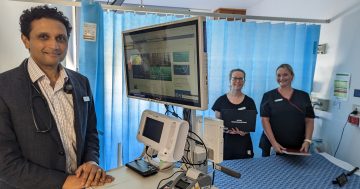
The percentage of urgent emergency department patients in the ACT who are seen within the recommended time of 30 minutes is less than half that of NSW. Photos: George Tsotsos.
The percentage of ‘urgent’ emergency department patients in the ACT who are seen within the recommended time of 30 minutes has fallen to 37 per cent and is the lowest in Australia according to a new Australian Medical Association report card on public hospitals.
The 2017-18 statistic of 37 per cent represents a drop from 50 per cent in 2016-17 and is less than half of the 76 per cent of NSW urgent patients who are seen by that state’s emergency departments within the 30-minute clinically recommended time period.
The ACT has also scored badly in several other areas of the report card which the AMA says “paints a depressing picture of overstretched hospitals and patients waiting longer for their care”.
AMA President, Dr Tony Bartone said that the ability of the hospitals to cope with ever-increasing patient demand continues to decline, and it is a trend that will only accelerate unless something is done.
“Emergency treatment times for ‘urgent’ patients have gone backwards in most states and territories. None have performed substantially better than last year,” Dr Bartone said.
“The picture for elective surgery is not much better, with most jurisdictions performing worse or remaining static.”
The AMA is calling on all the major parties to commit to significant new long-term funding for Australia’s public hospitals should they win Government on May 18.
Dr Bartone said that no jurisdiction improved performance across all indicators in the report card.
“The picture should be one of continual improvement. Sadly, it is not,” he said.
The ACT also scored badly when it came to transitioning emergency patients to hospital beds within the recommended four hours after their emergency treatment was finished (where a hospital bed was needed).

In the ACT, only 40 per cent of emergency patients who needed a subsequent admission made the transition within four hours.
“Nationally, less than 50 per cent (48.5 per cent) of this cohort transition from emergency to an in-patient bed within four hours. As expected, performance varies by jurisdiction,” the report stated.
In the ACT, only 40 per cent of emergency patients who needed a subsequent admission in 2017-18 made the transition within four hours. This was the second-worst percentage of all states and territories with only the Northern Territory scoring worse at 31 per cent.
“The delayed transition of patients to admitted ward beds threatens the safety and quality of patient care and diverts valuable emergency staff/resources away from patients still waiting for emergency treatment,” the report stated.
“It strongly suggests in-patient bed block and/or other resource shortages on public hospital wards.”
The ACT also fared badly when it came to elective surgery waiting times.
The report said that the median waiting time for elective surgery in the ACT in 2017-18 was 54 days. This was an increase from 46 days in 2016-17 and was the second-longest median waiting time of all states and territories.
Dr Bartone said that public hospitals are treating more patients each year and that greater funding is needed to lift the capacity of the hospitals.
“Across all types of public hospital service, the rate of increased demand is outstripping the 1.6 per cent per annum rate of population growth.”
Dr Bartone said the consequences of underfunding are significant.
“Underfunding can lead to increased numbers of deaths for admitted patients, higher levels complications, delayed care, delayed pain relief, and longer length of stay for patients,” he said.
“Greater funding is needed to support the highly-skilled, dedicated, and hardworking doctors, nurses, other health professionals, and hospital workers who are asked to do more with less every day.
“And greater funding is needed to ensure that patients can get access to high-quality care when they need it, without long waiting times.”
The 2019 AMA Public Hospital Report Card is available at https://ama.com.au/ama-public-hospital-report-card-2019


















